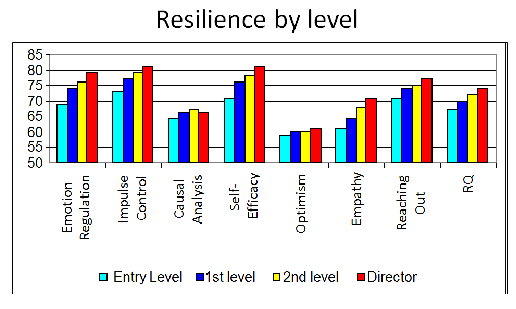Leading Across The Resilience & Optimism Gap - A Few Tips
Do you ever wonder why your team doesn't seem to be able to handle problems that you find easy to solve? When your people are giving excuses for why they can't meet their objectives, do you ask yourself why they can't just get it done? If so, you may be hitting up against the ‘Resilience & Optimism Gap'.
We've been getting more and more requests from client companies for our half day course that addresses this issue, so I thought a quick review of the problem, along with some tips for overcoming it, might be useful to our readers.
The higher you go in an organization, the more resilient and optimistic people tend to be. A decade of research at Adaptiv Learning Systems bears this out. This chart comes from our study of 375 managers and leaders at an operating unit of a Fortune 25 company, and these results are consistent with other groups we've studied. There is a consistent, step-wise increase in resilience, from front line employees, up through all levels of management and leadership.

This is because resilience and optimism are precisely the qualities that advance careers and get you promoted. But these strengths can be a double-edged sword. Managers and leaders wind up trying to lead their relatively less resilient and more pessimistic staffs. And they get frustrated because they don't get the results they expected from their teams. This is especially true in times of large scale change and uncertainty - which in most companies today is most of the time!
From their vantage point, many lower-level employees think their managers are overly optimistic and unrealistic. They dismiss their boss's directives, goals, and missions as unattainable and so do not work as hard as they might towards achieving them. We hear statements like, "This sounds like another 'initiative-du-jour' from on high - unrealistic as usual and impossible to achieve. So I'll just sit back and see if it fizzles out before I waste any time getting on board."
Here are a few tips from our program - "Communicating Across The Resilience & Optimism Gap" - to help you get your team moving in the right direction:
- Just be aware of the gap. Getting off auto-pilot is the first step. Once you're tuned into the fact that you may be thinking, feeling and acting differently from your team, you can begin to communicate in a way that your staff can better hear and identify with.
- Beware of mind-reading. You may expect your team to know what you're thinking and to share your perspective. Chances are they don't. The best way to counteract this is to communicate more fully. Provide more facts that support your case. Give them concrete evidence that your plan is achievable. Spend more time showing them the way. And then ask for feedback. Make sure they've heard you.
- Put yourself in their shoes. Ask yourself, "If I were in their place, how would I react to the message I'm trying to get them to buy into?" Acknowledge the differences in your thinking styles. A little bit of empathy will go a long way toward getting your team on board.
- Identify and empower your change agents. You'll certainly have at least one person on your team with higher levels of optimism and resilience than the rest. You can use this to your advantage by asking them to actively support your efforts with their peers. This might be easier said than done, but making this a part of your ongoing staff development program can help.
How do you lead across the resilience and optimism gap? We'd love to hear from you!


